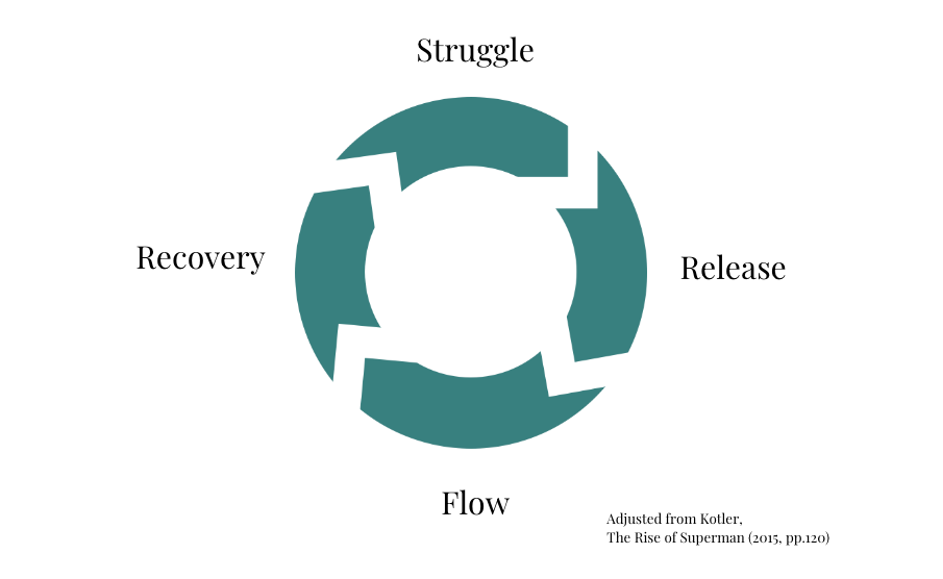Master the Flow Cycle and Upgrade your Productivity
What is Flow?
Have you ever been so absorbed in something that hours flew by like minutes? That's the magic of flow. It's that sweet spot where you're totally in the zone, crushing it, and loving every second.
Flow is a term coined by the psychologist Mihály Csíkszentmihályi. It occurs when the challenge of an activity matches your skill level, creating a perfect balance that keeps you engaged without overwhelming or boring you.
When you enter a flow state, your brain shifts into a mode of deep focus, allowing you to tap into your inner potential. Whether you're working on a project, playing a sport, or even engaging in a hobby, flow can elevate your experience, making tasks feel effortless and enjoyable.
The benefits of flow extend beyond just getting things done. Regularly experiencing flow can improve your mental wellbeing, reduce stress, and increase your overall satisfaction with life. By understanding and cultivating flow, you can enhance your productivity, boost creativity, and achieve greater personal and professional fulfillment.
A key part of cultivating flow in your life is to understand the Flow Cycle, which lays out the stages you go through before, during and after Flow.
The Flow Cycle
The Flow Cycle consists of four stages that you go through when experiencing flow. Every time you ‘flow’ you pass through all these stages and understanding them will help you to more consistently achieve flow in your life.
Flow Cycle Stages Explained
Phase 1 - Struggle
It might be surprising, but struggle is an inherent part of entering the flow state. To access that effortless state of focus and productivity, you must first pass through a period of struggle. This phase can last anywhere from a few seconds to 20 minutes or more. Many people never move beyond this stage because they distract themselves with their phones or by checking emails when resistance comes up and things get tough. This restarts the struggle phase each time. To make sure you move through this stage effectively, eliminate all distractions—turn off your phone, disable notifications, and create an environment conducive to deep work.
Phase 2 - Release
After the struggle comes the release phase, the gateway to flow. This is the moment just before you fully immerse yourself in your work. You might take a short walk, gaze out the window, or simply stare at the wall for a few minutes. These small acts help to release tension and prepare your mind for flow. It's crucial during this phase to avoid cognitively stimulating distractions, such as checking messages, as they can pull you out of the flow cycle before you even start to flow.
Phase 3 - Flow
This is the state you're aiming for—the feeling of effortless effort. In flow, you're fully focused, creating with ease, and losing track of time. During this phase, your brain shifts into alpha and even theta brainwaves, which means you're relaxed and tapping into your subconscious. This is where true creativity and productivity flourish.
Phase 4 - Recovery
The recovery phase is critical and often overlooked. Flow consumes a significant amount of energy, so it’s important to rest and engage in active recovery afterward to restore your energy. This allows you to perform at your best when you return for the next round of work. Prioritize this phase to ensure sustainable productivity and creativity.
Understanding and optimizing each phase of the flow cycle—struggle, release, flow, and recovery—will support you in your quest for more flow, productivity, and creativity.
FLOW. REST. REPEAT.
For me, understanding the mechanics of flow made a world of difference. Realizing that struggle is a natural part of the process—not a sign of failure—helped me embrace it as an essential step on the journey to creation, creativity, and effortless productivity.
My 5 Cents On This
Our brains are incredibly smart, and by understanding how they work, we can better design a life that supports the goals and experiences we truly want. For me, diving into the concept of Flow and the neuroscience behind it was a game changer. It opened the door to understanding how we can optimize both our performance and our wellbeing.
When you start to recognize the stages of the Flow Cycle and learn to observe yourself within the process, you can align your work with your brain's natural rhythms. Instead of relying on willpower or pushing through resistance, you start to work with your brain, not against it. This, in turn, leads to more productivity, less stress, and a greater sense of fulfillment.
So, the next time you're feeling stuck, frustrated, or overwhelmed, take a step back. Where are you in the Flow Cycle? Just knowing that can be the key to unlocking the next level of your productivity and personal growth.

